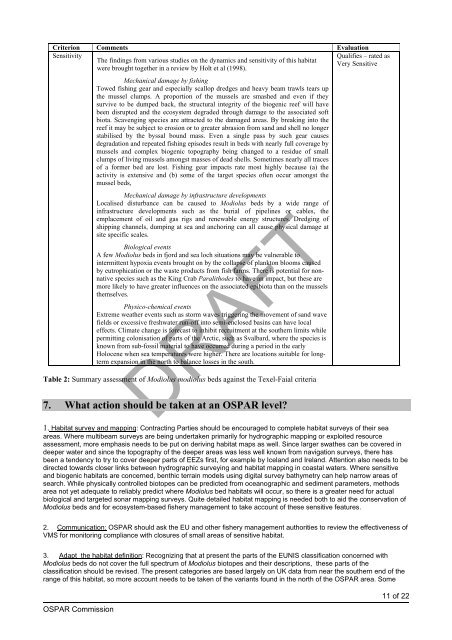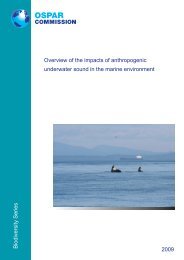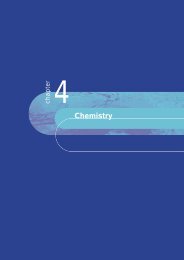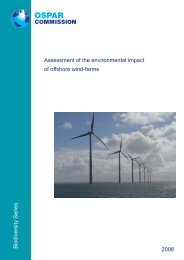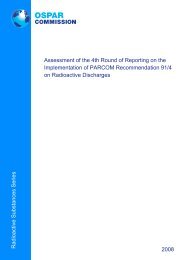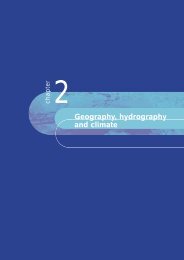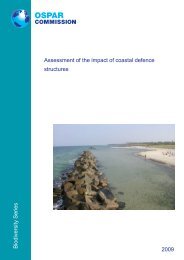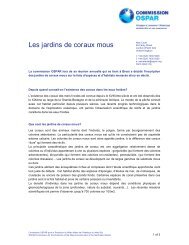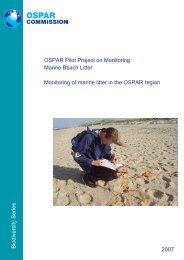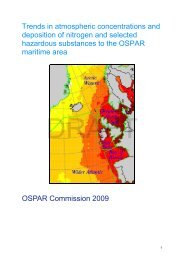Assessment of Modiolus modiolus beds in the OSPAR area Ivor ...
Assessment of Modiolus modiolus beds in the OSPAR area Ivor ...
Assessment of Modiolus modiolus beds in the OSPAR area Ivor ...
You also want an ePaper? Increase the reach of your titles
YUMPU automatically turns print PDFs into web optimized ePapers that Google loves.
Criterion Comments Evaluation<br />
Sensitivity<br />
The f<strong>in</strong>d<strong>in</strong>gs from various studies on <strong>the</strong> dynamics and sensitivity <strong>of</strong> this habitat<br />
were brought toge<strong>the</strong>r <strong>in</strong> a review by Holt et al (1998).<br />
Qualifies – rated as<br />
Very Sensitive<br />
<strong>OSPAR</strong> Commission<br />
Mechanical damage by fish<strong>in</strong>g<br />
Towed fish<strong>in</strong>g gear and especially scallop dredges and heavy beam trawls tears up<br />
<strong>the</strong> mussel clumps. A proportion <strong>of</strong> <strong>the</strong> mussels are smashed and even if <strong>the</strong>y<br />
survive to be dumped back, <strong>the</strong> structural <strong>in</strong>tegrity <strong>of</strong> <strong>the</strong> biogenic reef will have<br />
been disrupted and <strong>the</strong> ecosystem degraded through damage to <strong>the</strong> associated s<strong>of</strong>t<br />
biota. Scaveng<strong>in</strong>g species are attracted to <strong>the</strong> damaged <strong>area</strong>s. By break<strong>in</strong>g <strong>in</strong>to <strong>the</strong><br />
reef it may be subject to erosion or to greater abrasion from sand and shell no longer<br />
stabilised by <strong>the</strong> byssal bound mass. Even a s<strong>in</strong>gle pass by such gear causes<br />
degradation and repeated fish<strong>in</strong>g episodes result <strong>in</strong> <strong>beds</strong> with nearly full coverage by<br />
mussels and complex biogenic topography be<strong>in</strong>g changed to a residue <strong>of</strong> small<br />
clumps <strong>of</strong> liv<strong>in</strong>g mussels amongst masses <strong>of</strong> dead shells. Sometimes nearly all traces<br />
<strong>of</strong> a former bed are lost. Fish<strong>in</strong>g gear impacts rate most highly because (a) <strong>the</strong><br />
activity is extensive and (b) some <strong>of</strong> <strong>the</strong> target species <strong>of</strong>ten occur amongst <strong>the</strong><br />
mussel <strong>beds</strong>,<br />
Mechanical damage by <strong>in</strong>frastructure developments<br />
Localised disturbance can be caused to <strong>Modiolus</strong> <strong>beds</strong> by a wide range <strong>of</strong><br />
<strong>in</strong>frastructure developments such as <strong>the</strong> burial <strong>of</strong> pipel<strong>in</strong>es or cables, <strong>the</strong><br />
emplacement <strong>of</strong> oil and gas rigs and renewable energy structures. Dredg<strong>in</strong>g <strong>of</strong><br />
shipp<strong>in</strong>g channels, dump<strong>in</strong>g at sea and anchor<strong>in</strong>g can all cause physical damage at<br />
site specific scales.<br />
Biological events<br />
A few <strong>Modiolus</strong> <strong>beds</strong> <strong>in</strong> fjord and sea loch situations may be vulnerable to<br />
<strong>in</strong>termittent hypoxia events brought on by <strong>the</strong> collapse <strong>of</strong> plankton blooms caused<br />
by eutrophication or <strong>the</strong> waste products from fish farms. There is potential for nonnative<br />
species such as <strong>the</strong> K<strong>in</strong>g Crab Paralithodes to have an impact, but <strong>the</strong>se are<br />
more likely to have greater <strong>in</strong>fluences on <strong>the</strong> associated epibiota than on <strong>the</strong> mussels<br />
<strong>the</strong>mselves.<br />
Physico-chemical events<br />
Extreme wea<strong>the</strong>r events such as storm waves trigger<strong>in</strong>g <strong>the</strong> movement <strong>of</strong> sand wave<br />
fields or excessive freshwater run-<strong>of</strong>f <strong>in</strong>to semi-enclosed bas<strong>in</strong>s can have local<br />
effects. Climate change is forecast to <strong>in</strong>hibit recruitment at <strong>the</strong> sou<strong>the</strong>rn limits while<br />
permitt<strong>in</strong>g colonisation <strong>of</strong> parts <strong>of</strong> <strong>the</strong> Arctic, such as Svalbard, where <strong>the</strong> species is<br />
known from sub-fossil material to have occurred dur<strong>in</strong>g a period <strong>in</strong> <strong>the</strong> early<br />
Holocene when sea temperatures were higher. There are locations suitable for longterm<br />
expansion <strong>in</strong> <strong>the</strong> north to balance losses <strong>in</strong> <strong>the</strong> south.<br />
DRAFT<br />
Table 2: Summary assessment <strong>of</strong> <strong>Modiolus</strong> <strong>modiolus</strong> <strong>beds</strong> aga<strong>in</strong>st <strong>the</strong> Texel-Faial criteria<br />
7. What action should be taken at an <strong>OSPAR</strong> level?<br />
1. Habitat survey and mapp<strong>in</strong>g: Contract<strong>in</strong>g Parties should be encouraged to complete habitat surveys <strong>of</strong> <strong>the</strong>ir sea<br />
<strong>area</strong>s. Where multibeam surveys are be<strong>in</strong>g undertaken primarily for hydrographic mapp<strong>in</strong>g or exploited resource<br />
assessment, more emphasis needs to be put on deriv<strong>in</strong>g habitat maps as well. S<strong>in</strong>ce larger swa<strong>the</strong>s can be covered <strong>in</strong><br />
deeper water and s<strong>in</strong>ce <strong>the</strong> topography <strong>of</strong> <strong>the</strong> deeper <strong>area</strong>s was less well known from navigation surveys, <strong>the</strong>re has<br />
been a tendency to try to cover deeper parts <strong>of</strong> EEZs first, for example by Iceland and Ireland. Attention also needs to be<br />
directed towards closer l<strong>in</strong>ks between hydrographic survey<strong>in</strong>g and habitat mapp<strong>in</strong>g <strong>in</strong> coastal waters. Where sensitive<br />
and biogenic habitats are concerned, benthic terra<strong>in</strong> models us<strong>in</strong>g digital survey bathymetry can help narrow <strong>area</strong>s <strong>of</strong><br />
search. While physically controlled biotopes can be predicted from oceanographic and sediment parameters, methods<br />
<strong>area</strong> not yet adequate to reliably predict where <strong>Modiolus</strong> bed habitats will occur, so <strong>the</strong>re is a greater need for actual<br />
biological and targeted sonar mapp<strong>in</strong>g surveys. Quite detailed habitat mapp<strong>in</strong>g is needed both to aid <strong>the</strong> conservation <strong>of</strong><br />
<strong>Modiolus</strong> <strong>beds</strong> and for ecosystem-based fishery management to take account <strong>of</strong> <strong>the</strong>se sensitive features.<br />
2. Communication: <strong>OSPAR</strong> should ask <strong>the</strong> EU and o<strong>the</strong>r fishery management authorities to review <strong>the</strong> effectiveness <strong>of</strong><br />
VMS for monitor<strong>in</strong>g compliance with closures <strong>of</strong> small <strong>area</strong>s <strong>of</strong> sensitive habitat.<br />
3. Adapt <strong>the</strong> habitat def<strong>in</strong>ition: Recogniz<strong>in</strong>g that at present <strong>the</strong> parts <strong>of</strong> <strong>the</strong> EUNIS classification concerned with<br />
<strong>Modiolus</strong> <strong>beds</strong> do not cover <strong>the</strong> full spectrum <strong>of</strong> <strong>Modiolus</strong> biotopes and <strong>the</strong>ir descriptions, <strong>the</strong>se parts <strong>of</strong> <strong>the</strong><br />
classification should be revised. The present categories are based largely on UK data from near <strong>the</strong> sou<strong>the</strong>rn end <strong>of</strong> <strong>the</strong><br />
range <strong>of</strong> this habitat, so more account needs to be taken <strong>of</strong> <strong>the</strong> variants found <strong>in</strong> <strong>the</strong> north <strong>of</strong> <strong>the</strong> <strong>OSPAR</strong> <strong>area</strong>. Some<br />
11 <strong>of</strong> 22


